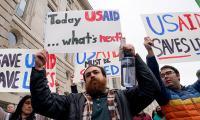Part - I
Governing a province in Pakistan is not a job one would consider powerless. But if you are the ruling party of Khyber Pakhtunkhwa it means your influence is limited. Geographically, the provincial capital is surrounded on three sides by Fata (hence outside the governor’s control), and to the north the districts from Malakand to Chitral are governed by the Provincially Administered Tribal Areas laws and require gubernatorial endorsement of any laws.
Economically, the province is more than 90 percent dependent on federal government royalties and the federal ruling party can (and has done so in the past) at a whim bring the provincial government to its financial knees.
Politically, the situation is even more complicated. Khyber Pakhtunkhwa is a multi-party province which has been ruled by coalition governments since the 1970s. This is complicated by the post-2001 dynamics; the last three elections have seen a ‘wave’. These anti-incumbent government waves have led to the vast majority of sitting MPAs and MNAs being routed out.
Over the last many years, the province’s voters are seen as an aberration in Pakistani politics – voting out every party come re-election.
There are several myths that have arisen since the 2013 elections. The first is that the PTI wave was notable for the unprecedented turnout in favour of the ‘tsunami’. The facts say otherwise. The turnout in KP was between 40 and 44 percent, depending on whether one was looking at votes cast for provincial assembly or National Assembly seats. The turnout was lower than both Punjab and Sindh, but was higher than the 2008 elections.
The next myth is that the average KP voter is significantly more pro-PTI than the PTI voter in Punjab. This is also incorrect. When the numbers are broken down, the PTI polled only marginally more votes in KP compared to Punjab – a mere 0.2 percent to more to be accurate. This is statistically a minor difference.
The final myth is that the PTI’s victory was because of disillusionment with the traditional parties, in particular the previous ruling party in KP: the ANP. Conversely, both coalition partners – the ANP and the PPP – attribute their defeat more to the relentless attacks by the TTP that crippled their ability to campaign in any real manner. This is probably the most interesting statistical aspect to the last election. The only KP party to see a significant decline in the votes polled in 2013 compared to 2008 was the PPP. The votes polled by the ANP were largely the same as the 2008 election. But due to the increase in turnout to the benefit of the PTI, the ANP and the PPP saw a significant decline in the percentage of their share of the vote.
The ANP saw its share of the vote fall from 17 percent to 10.1 percent while the PPP saw its share of the vote fall from 16.5 to 8.6. The PML-N doubled its share of the vote and votes polled and the JUI-F polled more votes but saw its share decline from 14.6 percent to 13.3 percent.
The final myth is that the traditional independent voter en masse switched to the PTI, upsetting the province’s multi-party dynamics. Again the breakdown shows the independent share of the vote decline, 15.8 percent from a high 24.1 percent, but no dramatic drop in votes polled. If anything, there has been a marginal increase.
This suggests that the average PTI voter will most likely be a new voter. The rest are likely to be former PML, PPP voters or independent. They are federal in their outlook but see the PTI as a vehicle for KP issues, even though the party’s central leadership does not reflect them in ethnicity, life experiences or age. They are cross-ethnic and do not get tied down by traditional KP geographic boundaries.
In terms of the opposition, it suggests that most parties are struggling to recruit new voters in keeping with the provinces population growth rate. It shows a progressive and dramatic decline in the PPP. Even during the MMA wave, the PPP managed to poll over 9 percent of the vote from an all-time high of 22.5 percent in the 1988 election. The PML-N at its height polled the highest percentage of KP votes of any single party. In the 1997 election, it managed 37 percent of the provincial vote (benefitting from low turnout and the JI boycott). The PML-N has now stabilised its vote at near the 18 percent level. This suggests a consolidation of the party voter after the PML-Q and PML-N vote.
The ANP, on the other hand, has now reverted to a weaker version of its 1990s position. An influential player, but one with not enough votes to ensure victory without a coalition partner. The JUI and JI’s aggregated vote has returned to the 1990s level too, hitting near the 20 percent margin. But as 2002 showed, in the right alliance and depending on the voters’ mood this can be decisive in forming a government.
In terms of the myths mentioned above, the last ones are the unspoken ones; the first is one that PTI supporters and anti-status quo voters hold: that the opposition parties are finished and a new era has arrived. This, as the statistics show, is not true.
The last unspoken myth, held dear by PTI opponents, suggests that the PTI is a onetime phenomenon and will be wiped out in the next election. We follow this in the next article in the series.
To be continued
The writer is the founder of the website: www.qissa-khwani.com
Twitter: @qissakhwani
In meeting at CM House it was said that 16 million children aged five to sixteen years are enrolled across Sindh
Agriculture is backbone of Sindh’s economy, contributing significantly to Pakistan’s GDP
Availability of information about performance of public entities is restrictive despite clear provisions of law
For countries like Pakistan, where climate emergency is harsh reality, these words carry profound significance
Pakistan has seen many cases where state enforced moral policing under air of sheltering social values
Is world ready for such technology to take over and gratify our need for connection in coming times?







